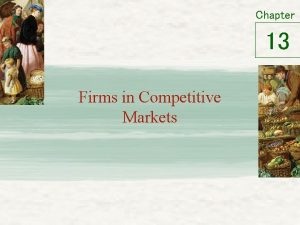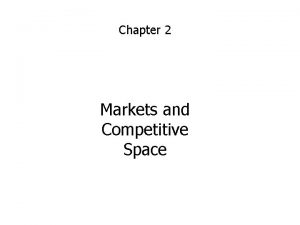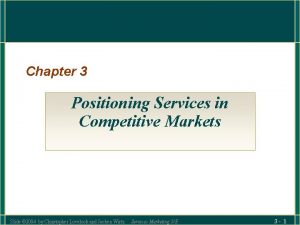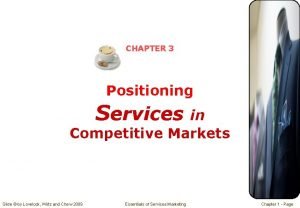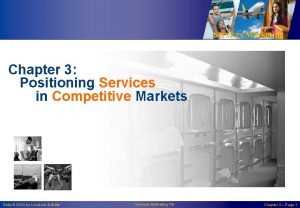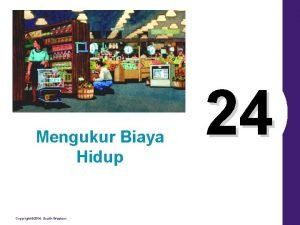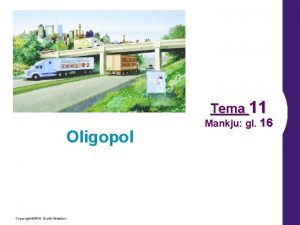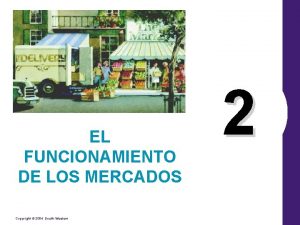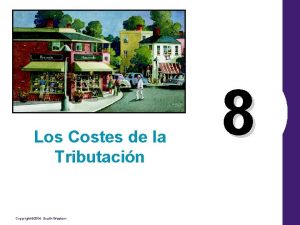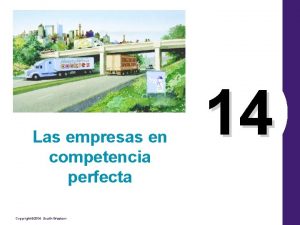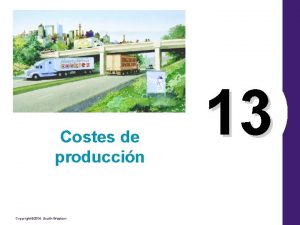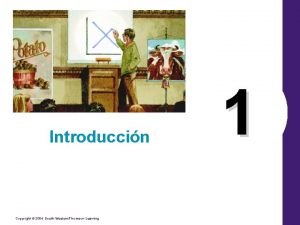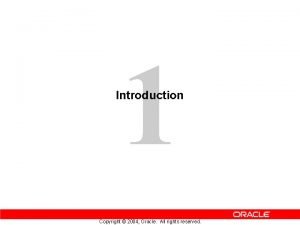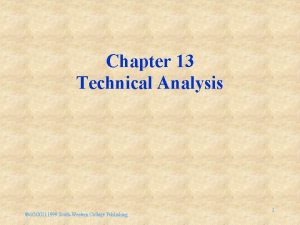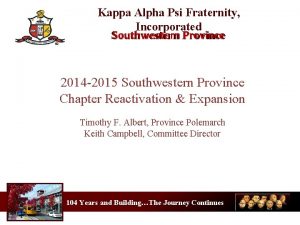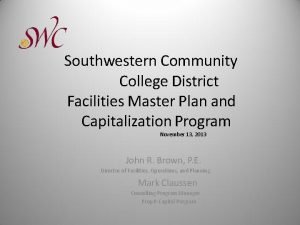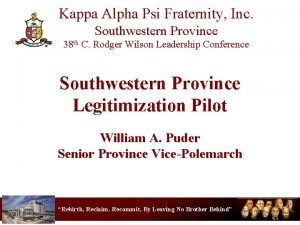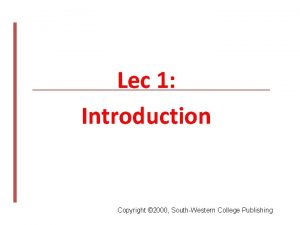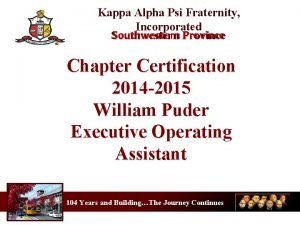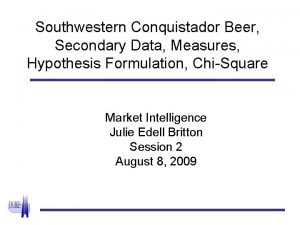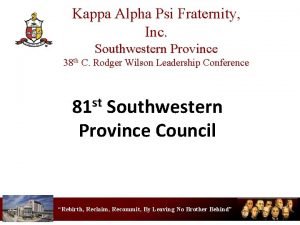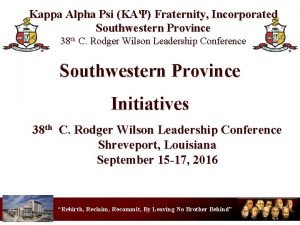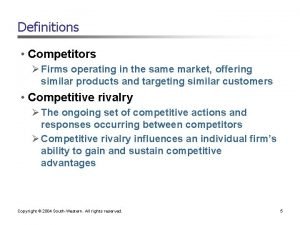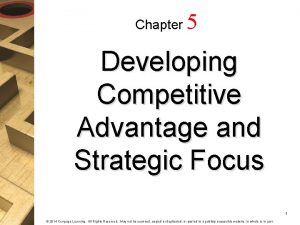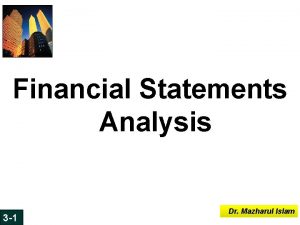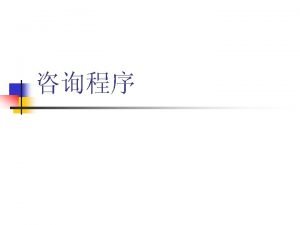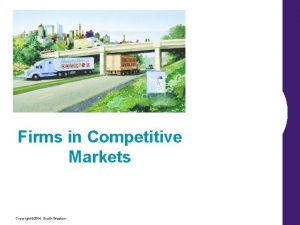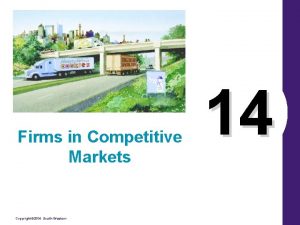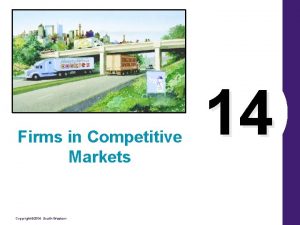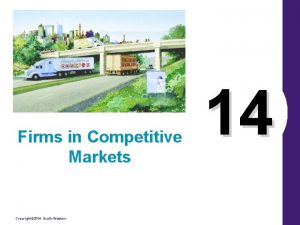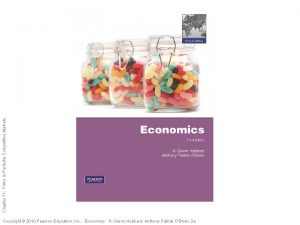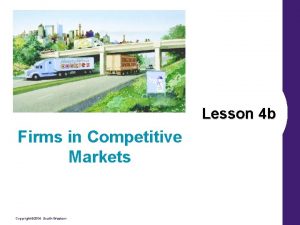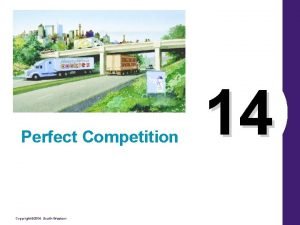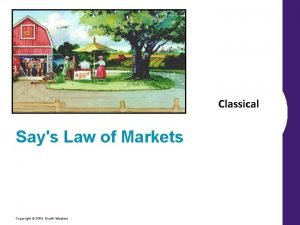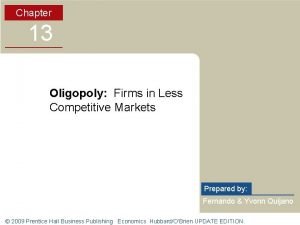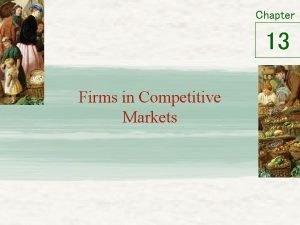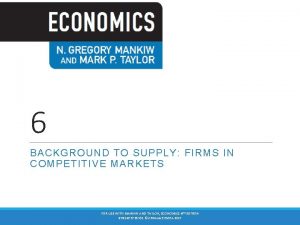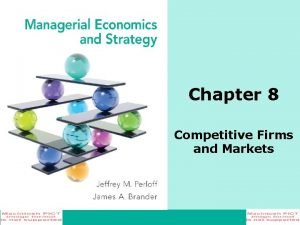Firms in Competitive Markets Copyright 2004 SouthWestern 14














































- Slides: 46

Firms in Competitive Markets Copyright© 2004 South-Western 14

WHAT IS A COMPETITIVE MARKET? • A perfectly competitive market has the following characteristics: • There are many buyers and sellers in the market. • The goods offered by the various sellers are largely the same. • Firms can freely enter or exit the market. Copyright © 2004 South-Western

WHAT IS A COMPETITIVE MARKET? • As a result of its characteristics, the perfectly competitive market has the following outcomes: • The actions of any single buyer or seller in the market have a negligible impact on the market price. • Each buyer and seller takes the market price as given. Copyright © 2004 South-Western

WHAT IS A COMPETITIVE MARKET? • A competitive market has many buyers and sellers trading identical products so that each buyer and seller is a price taker. • Buyers and sellers must accept the price determined by the market. Copyright © 2004 South-Western

The Revenue of a Competitive Firm • Total revenue for a firm is the selling price times the quantity sold. TR = (P Q) Copyright © 2004 South-Western

The Revenue of a Competitive Firm • Total revenue is proportional to the amount of output. Copyright © 2004 South-Western

The Revenue of a Competitive Firm • Average revenue tells us how much revenue a firm receives for the typical unit sold. • Average revenue is total revenue divided by the quantity sold. Copyright © 2004 South-Western

The Revenue of a Competitive Firm • In perfect competition, average revenue equals the price of the good. Copyright © 2004 South-Western

The Revenue of a Competitive Firm • Marginal revenue is the change in total revenue from an additional unit sold. MR = TR/ Q Copyright © 2004 South-Western

The Revenue of a Competitive Firm • For competitive firms, marginal revenue equals the price of the good. Copyright © 2004 South-Western

Table 1 Total, Average, and Marginal Revenue for a Competitive Firm Copyright© 2004 South-Western

PROFIT MAXIMIZATION AND THE COMPETITIVE FIRM’S SUPPLY CURVE • The goal of a competitive firm is to maximize profit. • This means that the firm will want to produce the quantity that maximizes the difference between total revenue and total cost. Copyright © 2004 South-Western

Table 2 Profit Maximization: A Numerical Example Copyright© 2004 South-Western

Figure 1 Profit Maximization for a Competitive Firm Costs and Revenue The firm maximizes profit by producing the quantity at which marginal cost equals marginal revenue. MC MC 2 ATC P = MR 1 = MR 2 AVC P = AR = MR MC 1 0 Q 1 QMAX Q 2 Quantity Copyright © 2004 South-Western

PROFIT MAXIMIZATION AND THE COMPETITIVE FIRM’S SUPPLY CURVE • Profit maximization occurs at the quantity where marginal revenue equals marginal cost. Copyright © 2004 South-Western

PROFIT MAXIMIZATION AND THE COMPETITIVE FIRM’S SUPPLY CURVE • When MR > MC increase Q • When MR < MC decrease Q • When MR = MC Profit is maximized. Copyright © 2004 South-Western

Figure 2 Marginal Cost as the Competitive Firm’s Supply Curve Price P 2 This section of the firm’s MC curve is also the firm’s supply curve. MC ATC P 1 AVC 0 Q 1 Q 2 Quantity Copyright © 2004 South-Western

The Firm’s Short-Run Decision to Shut Down • A shutdown refers to a short-run decision not to produce anything during a specific period of time because of current market conditions. • Exit refers to a long-run decision to leave the market. Copyright © 2004 South-Western

The Firm’s Short-Run Decision to Shut Down • The firm considers its sunk costs when deciding to exit, but ignores them when deciding whether to shut down. • Sunk costs are costs that have already been committed and cannot be recovered. Copyright © 2004 South-Western

The Firm’s Short-Run Decision to Shut Down • The firm shuts down if the revenue it gets from producing is less than the variable cost of production. • Shut down if TR < VC • Shut down if TR/Q < VC/Q • Shut down if P < AVC Copyright © 2004 South-Western

Figure 3 The Competitive Firm’s Short Run Supply Curve Costs If P > ATC, the firm will continue to produce at a profit. Firm’s short-run supply curve MC ATC If P > AVC, firm will continue to produce in the short run. AVC Firm shuts down if P< AVC 0 Quantity Copyright © 2004 South-Western

The Firm’s Short-Run Decision to Shut Down • The portion of the marginal-cost curve that lies above average variable cost is the competitive firm’s short-run supply curve. Copyright © 2004 South-Western

The Firm’s Long-Run Decision to Exit or Enter a Market • In the long run, the firm exits if the revenue it would get from producing is less than its total cost. • Exit if TR < TC • Exit if TR/Q < TC/Q • Exit if P < ATC Copyright © 2004 South-Western

The Firm’s Long-Run Decision to Exit or Enter a Market • A firm will enter the industry if such an action would be profitable. • Enter if TR > TC • Enter if TR/Q > TC/Q • Enter if P > ATC Copyright © 2004 South-Western

Figure 4 The Competitive Firm’s Long-Run Supply Curve Costs Firm’s long-run supply curve Firm enters if P > ATC MC = long-run S ATC Firm exits if P < ATC 0 Quantity Copyright © 2004 South-Western

THE SUPPLY CURVE IN A COMPETITIVE MARKET • The competitive firm’s long-run supply curve is the portion of its marginal-cost curve that lies above average total cost. Copyright © 2004 South-Western

Figure 4 The Competitive Firm’s Long-Run Supply Curve Costs MC Firm’s long-run supply curve ATC 0 Quantity Copyright © 2004 South-Western

THE SUPPLY CURVE IN A COMPETITIVE MARKET • Short-Run Supply Curve • The portion of its marginal cost curve that lies above average variable cost. • Long-Run Supply Curve • The marginal cost curve above the minimum point of its average total cost curve. Copyright © 2004 South-Western

Figure 5 Profit as the Area between Price and Average Total Cost (a) A Firm with Profits Price MC ATC Profit P ATC P = AR = MR 0 Quantity Q (profit-maximizing quantity) Copyright © 2004 South-Western

Figure 5 Profit as the Area between Price and Average Total Cost (b) A Firm with Losses Price MC ATC P P = AR = MR Loss 0 Q (loss-minimizing quantity) Quantity Copyright © 2004 South-Western

THE SUPPLY CURVE IN A COMPETITIVE MARKET • Market supply equals the sum of the quantities supplied by the individual firms in the market. Copyright © 2004 South-Western

The Short Run: Market Supply with a Fixed Number of Firms • For any given price, each firm supplies a quantity of output so that its marginal cost equals price. • The market supply curve reflects the individual firms’ marginal cost curves. Copyright © 2004 South-Western

Figure 6 Market Supply with a Fixed Number of Firms (a) Individual Firm Supply (b) Market Supply Price MC Supply $2. 00 1. 00 0 100 200 Quantity (firm) 0 100, 000 200, 000 Quantity (market) Copyright © 2004 South-Western

The Long Run: Market Supply with Entry and Exit • Firms will enter or exit the market until profit is driven to zero. • In the long run, price equals the minimum of average total cost. • The long-run market supply curve is horizontal at this price. Copyright © 2004 South-Western

Figure 7 Market Supply with Entry and Exit (a) Firm’s Zero-Profit Condition (b) Market Supply Price MC ATC P = minimum ATC 0 Supply Quantity (firm) 0 Quantity (market) Copyright © 2004 South-Western

The Long Run: Market Supply with Entry and Exit • At the end of the process of entry and exit, firms that remain must be making zero economic profit. • The process of entry and exit ends only when price and average total cost are driven to equality. • Long-run equilibrium must have firms operating at their efficient scale. Copyright © 2004 South-Western

Why Do Competitive Firms Stay in Business If They Make Zero Profit? • Profit equals total revenue minus total cost. • Total cost includes all the opportunity costs of the firm. • In the zero-profit equilibrium, the firm’s revenue compensates the owners for the time and money they expend to keep the business going. Copyright © 2004 South-Western

A Shift in Demand in the Short Run and Long Run • An increase in demand raises price and quantity in the short run. • Firms earn profits because price now exceeds average total cost. Copyright © 2004 South-Western

Figure 8 An Increase in Demand in the Short Run and Long Run (a) Initial Condition Market Firm Price MC ATC P 1 Short-run supply, S 1 P 1 A Long-run supply Demand, D 1 0 Quantity (firm) 0 Q 1 Quantity (market)

Figure 8 An Increase in Demand in the Short Run and Long Run (b) Short-Run Response Market Firm Price Profit MC ATC P 2 B P 2 P 1 S 1 A D 2 Long-run supply D 1 0 Quantity (firm) 0 Q 1 Q 2 Quantity (market) Copyright © 2004 South-Western

Figure 8 An Increase in Demand in the Short Run and Long Run (c) Long-Run Response Market Firm Price MC ATC P 1 B P 2 P 1 S 2 C A Long-run supply D 2 D 1 0 Quantity (firm) 0 Q 1 Q 2 Q 3 Quantity (market) Copyright © 2004 South-Western

• Marginal Firm • The marginal firm is the firm that would exit the market if the price were any lower. Copyright © 2004 South-Western

Summary • Because a competitive firm is a price taker, its revenue is proportional to the amount of output it produces. • The price of the good equals both the firm’s average revenue and its marginal revenue. Copyright © 2004 South-Western

Summary • To maximize profit, a firm chooses the quantity of output such that marginal revenue equals marginal cost. • This is also the quantity at which price equals marginal cost. • Therefore, the firm’s marginal cost curve is its supply curve. Copyright © 2004 South-Western

Summary • In the short run, when a firm cannot recover its fixed costs, the firm will choose to shut down temporarily if the price of the good is less than average variable cost. • In the long run, when the firm can recover both fixed and variable costs, it will choose to exit if the price is less than average total cost. Copyright © 2004 South-Western

Summary • In a market with free entry and exit, profits are driven to zero in the long run and all firms produce at the efficient scale. • Changes in demand have different effects over different time horizons. • In the long run, the number of firms adjusts to drive the market back to the zero-profit equilibrium. Copyright © 2004 South-Western
 Long run market supply curve
Long run market supply curve Firms in competitive markets chapter 14 ppt
Firms in competitive markets chapter 14 ppt In a competitive price-searcher market, the firms will
In a competitive price-searcher market, the firms will Product market boundaries and structures
Product market boundaries and structures Market positioning services
Market positioning services Positioning services in competitive markets
Positioning services in competitive markets Basic focus strategies for services
Basic focus strategies for services Konsep biaya hidup
Konsep biaya hidup Nesova ravnoteza
Nesova ravnoteza Copyright 2004
Copyright 2004 Copyright 2004
Copyright 2004 Copyright 2004
Copyright 2004 Légende amérindienne sirop d érable
Légende amérindienne sirop d érable Externalidades positivas
Externalidades positivas Copyright 2004
Copyright 2004 Copyright 2004
Copyright 2004 Copyright 2004
Copyright 2004 Copyright 2004
Copyright 2004 Copyright 2004
Copyright 2004 Market structure from most competitive to least competitive
Market structure from most competitive to least competitive Therapeutic index
Therapeutic index Competitive dynamics examples
Competitive dynamics examples Southwestern college publishing
Southwestern college publishing Kappa alpha psi southwestern province
Kappa alpha psi southwestern province Southwestern community college
Southwestern community college Catherine carpenter southwestern
Catherine carpenter southwestern Southwestern college cincinnati ohio
Southwestern college cincinnati ohio Kappa alpha psi southwestern province
Kappa alpha psi southwestern province South-western college publishing
South-western college publishing William puder kappa alpha psi
William puder kappa alpha psi Southwestern conquistador beer case solution
Southwestern conquistador beer case solution Kappa alpha psi southwestern province
Kappa alpha psi southwestern province Mse bba
Mse bba Kappa alpha psi southwestern province
Kappa alpha psi southwestern province Thomson southwestern
Thomson southwestern Province of texas
Province of texas Southwestern educational publishing
Southwestern educational publishing Joshua zaffos md
Joshua zaffos md Southwestern college publishing
Southwestern college publishing Pakistan council of architects and town planners
Pakistan council of architects and town planners Firms operating in the same market
Firms operating in the same market Developing a firms strategy canvas focuses on
Developing a firms strategy canvas focuses on Managing human resources in small and entrepreneurial firms
Managing human resources in small and entrepreneurial firms The fire information for resource management system
The fire information for resource management system Chapter 7 market structures
Chapter 7 market structures Ocfcl
Ocfcl Proposal consulting firms,
Proposal consulting firms,
